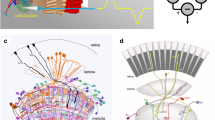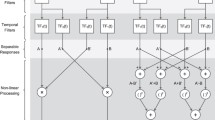Abstract
The tangential neurons in the lobula plate region of the flies are known to respond to visual motion across broad receptive fields in visual space.When intracellular recordings are made from tangential neurons while the intact animal is stimulated visually with moving natural imagery,we find that neural response depends upon speed of motion but is nearly invariant with respect to variations in natural scenery. We refer to this invariance as velocity constancy. It is remarkable because natural scenes, in spite of similarities in spatial structure, vary considerably in contrast, and contrast dependence is a feature of neurons in the early visual pathway as well as of most models for the elementary operations of visual motion detection. Thus, we expect that operations must be present in the processing pathway that reduce contrast dependence in order to approximate velocity constancy.We consider models for such operations, including spatial filtering, motion adaptation, saturating nonlinearities, and nonlinear spatial integration by the tangential neurons themselves, and evaluate their effects in simulations of a tangential neuron and precursor processing in response to animated natural imagery. We conclude that all such features reduce interscene variance in response, but that the model system does not approach velocity constancy as closely as the biological tangential cell.
Similar content being viewed by others
Reference
Borst A, Egelhaaf M, Haag J (1995) Mechanisms of dendritic integration underlying gain control in fly motion-sensitive neurons. J Comput Neurosci 2:5–18
Buchner E (1976) Elementary movement detectors in an insect visual system. Biol Cybernet 24:85–101
Clifford CWG, Ibbotson MR (2003) Fundamental mechanisms of visual motion detection: models, cells and functions. Prog Neurobiol 68:409–437
Clifford CWG, Langley K (1996) Psychophysics of motion adaptation parallels insect electrophysiology. Curr Biol 6:1340–1342
de Ruyter van Steveninck R, Zaagman WH, Mastebroek HAK (1986) Adaptation of transient responses of a movement-sensitive neuron in the visual system of the blowfly Calliphora erythrocephala. Biol Cybernet 54:223–236
Douglass JK, Strausfeld N (1995) Visual motion detection circuits in flies: peripheral motion computation by identified small-field retinotopic neurons. J Neurosci 15:5596–5611
Dror RO, O’Carroll DC, Laughlin SB (2001) Accuracy of velocity estimation by Reichardt correlators. J Opt Soc Am A 18:241–252
Egelhaaf M, Borst A (1993) A look into the cockpit of the fly: visual orientation, algorithms, and identified neurons. J Neurosci 13:4563–4574
Egelhaaf M, Borst A, Reichardt W (1989) Computational structure of a biological motion-detection system as revealed by local detector analysis in the fly’s nervous system. J Opt Soc Am A 6:1070–1087
Fairhall AL, Lewen GD, Bialek W, de Ruyter van Steveninck R (2001) Efficiency and ambiguity in an adaptive neural code. Nature 41:787–792
Franceschini N, Riehle A, Le Nestour A (1989) Directionally selective motion detection by insect neurons. In: Stavenga DG, Hardie RC (eds) Facets of vision, Springer, Berlin Heidelberg New York, pp 360–390
Franz MO, Krapp HG (1998) Wide-field, motion-sensitive neurons and matched filters for optic flow fields. Biol Cybernet 83:185–197
Götz KG (1964) Optomotorische untersuchung des visuellen systems einiger augenmutanten der fruchtfliege drosophila. Kybernetik 2:77–92
Haag J, Egelhaaf M, Borst A (1992) Dendritic integration of motion information in visual interneurons of the blowfly. Neurosci Lett 140:173–176
Harris RA, O’Carroll DC, Laughlin SB (1999) Adaptation and the temporal filter of fly motion detectors. Vision Res 39:2603–2613
Harris RA, O’Carroll DC, Laughlin SB (2000) Contrast gain reduction in fly motion adaptation. Neuron 28:595–606
Harrison RR, Koch C (2001) A silicon model of the fly’s optomotor control system. Neural Comput 12: 2291–2304
Hassenstein B, Reichardt W (1956) Systemtheoretische analyse der zeit-, reihenfolgen-, und vorseichenauswertung bei der berwegungsperzeption des rüsselkäfers chlorophanus. Z Naturforsch 11b:513–524
Hausen K (1982) Motion-sensitive interneurons in the optomotor system of the fly. II. The horizontal cells: receptive field organization and response characteristics. Biol Cybernet 46:67–79
Hausen K (1993) The decoding of retinal image flow in insects. In: Miles FA, Wallman J (eds) Visual motion and its role in the stabilisation of gaze. Elsevier, London
Hausen K, Egelhaaf M (1989) Neural mechanisms of visual course control in insects. In: Stavenga DG, Hardie RC (eds) Facets of vision, Springer, Berlin Heidelberg New York, pp 391–424
Higgins CM, Douglass JK, Strausfeld NJ (2004) The computational basis of an identified neuronal circuit for elementary motion detection in dipterous insects. Vis Neurosci 21:567–586
James AC (1992) Nonlinear operator network models of processing in the fly lamina. In: Nabet B (ed) Nonlinear vision. CRC, Boca Raton, FL, pp 39–74
Kern R, Lutterklas M, Petereit C, Lindemann JP, Egelhaaf M (2001) Neuronal processing of behaviourally generated optic flow: experiments and model simulations. Netw Comput Neural Syst 12:351–369
Kirschfeld K (1972) The visual system of Musca: studies on optics, structure, and function. In: Wehner R (ed) Information processing in the visual system of arthropods. Springer, Berlin Heidelberg New York, pp 61–74
Kirschfeld K (1991) An optomotor control system with automatic compensation for contrast and texture. Proc R Soc Lond B Biol Sci 246:261–268
Krapp HG, Hengstenberg B, Hengstenberg R (1998) Dendritic structure and receptive-field organization of optic flow processing interneurons in the fly. J Neurophysiol 79:1902–1917
Laughlin SB, Weckström M (1993) Fast and slow photoreceptors—a comparative study of the functional diversity of coding and conductances in the diptera. J Comp Physiol A 172:593–609
Lipetz LE (1971) The relation of physiological and psychological aspects of sensory intensity. In: Loewenstein WR (ed) Handbook of sensory physiology. Springer, Berlin Heidelberg New York, pp 192–225
Maddess T, Laughlin SB (1985) Adaptation of the motion-sensitive neuron H1 is generated locally and governed by contrast frequency. Proc R Soc Lond B Biol Sci 225:251–275
Naka KI, Rushton WAH (1966) S-potentials from luminosity units in retina of fish (Cyprinidae). J Physiol Lond 185:587–599
Poggio T, Reichardt W, Hausen K (1981) A neural circuitry for relative movement discrimination by the visual system of the fly. Naturwissenschaften 443:446
Potters M, Bialek W (1994) Statistical mechanics and visual signal processing. J Phys IV Colloq I 4:1755–1775
Ruderman DL (1994) The statistics of natural images. Netw Comput Neural Syst 5:517–548
Snyder AW (1979) Physics of vision in compound eyes. In: Autrum H (ed) Comparative physiology and evolution of vision in invertebrates: invertebrate photoreceptors, vol VII/6A of handbook of sensory physiology. Springer, Berlin Heidelberg New York, pp 225–313
Snyder AW, Stavenga DF, Laughlin SB (1977) Spatial information capacity of the eyes. J Comp Physiol 116:183–207
Srinivasan MV, Guy RG (1990) Spectral properties of movement perception in the dronefly Eristalis. J Comp Physiol A 166:287–295
Srinivasan MV, Laughlin SB, Dubs A (1982) Predictive coding: a fresh view of inhibition in the retina. Proc R Soc Lond B Biol Sci 216:427–459
Straw A, Rainsford T, O’Carroll D (2005) Estimates of natural scene velocity in fly motion detectors are contrast independent. Curr Biol (submitted)
Tolhurst DJ, Tadmor Y, Chao T (1992) Amplitude spectra of natural images. Ophthalmol Physiol Opt 12:229–232
van Hateren JH (1990) Directional tuning curves, elementary movement detectors, and the estimation of the direction of visual movement. Vision Res 30:603–614
van Hateren JH (1992) Theoretical predictions of spatiotemporal receptive fields of fly LMCs, and experimental validation. J Comp Physiol A 171:157–170
van Hateren JH (1997) Processing of natural time series of intensities by the visual system of the blowfly. Vision Res 37:3407–3416
van Hateren JH, Snippe HP (2001) Information theoretical evaluation on parametric models of gain control in blowfly photoreceptor cells. Vision Res 41:1851–1865
This work was supported by US Air Force SBIR contract F08630-02-C-0013 and by USAir Force IRI grant F62562-01- P-0158. Straw was supported by a fellowship from the Howard Hughes Medical Institute. Data on velocity constancy were contributed in part by T. Rainsford. The authors thank T. Bartolac for data processing and for comments on the manuscript.
Author information
Authors and Affiliations
Corresponding author
Appendix
Appendix
To quantify the degree of saturation of a signal subjected to a limiting nonlinearity, we measured the fraction of time during the course of a simulation that the signal resides in the upper 10% or lower 10% of the range of the nonlinear function. The time spent in transition between these states is therefore consistent with the engineering concept of rise or fall time. We define moderate saturation as corresponding to 60–65% of simulated time spent in those parts of the range near the extrema, by the above criterion. This criterion was applied to both saturating nonlinearities, at early vision output and at EMD correlator output.
When a limiting nonlinearity was included in the signal path in simulations of the motion processing pathway, we measured and averaged the time spent near the extrema for the limited signal at five different latitudinal locations in the array, and adjusted the scaling of the signal at the input to the nonlinear block with the goal of obtaining moderate saturation. When motion adaptation was included in the model, a single scaling constant could be found that achieved moderate saturation for all five animated images in the test set, in all cases. However, when motion adaptation was not included, saturation necessarily fell outside the moderate range for some of the images in the set, due to the differing global contrasts. In these instances, the time spent near the extrema ranged from 48.5% to 52.3% for the lowest-contrast image gardens, and 82.3% to 89.0% for the image hamlin. The other three images were in or near the moderate saturation range.
Rights and permissions
About this article
Cite this article
Shoemaker, P.A., O’Carroll, D.C. & Straw, A.D. Velocity constancy and models for wide-field visual motion detection in insects. Biol Cybern 93, 275–287 (2005). https://doi.org/10.1007/s00422-005-0007-y
Received:
Accepted:
Published:
Issue Date:
DOI: https://doi.org/10.1007/s00422-005-0007-y




